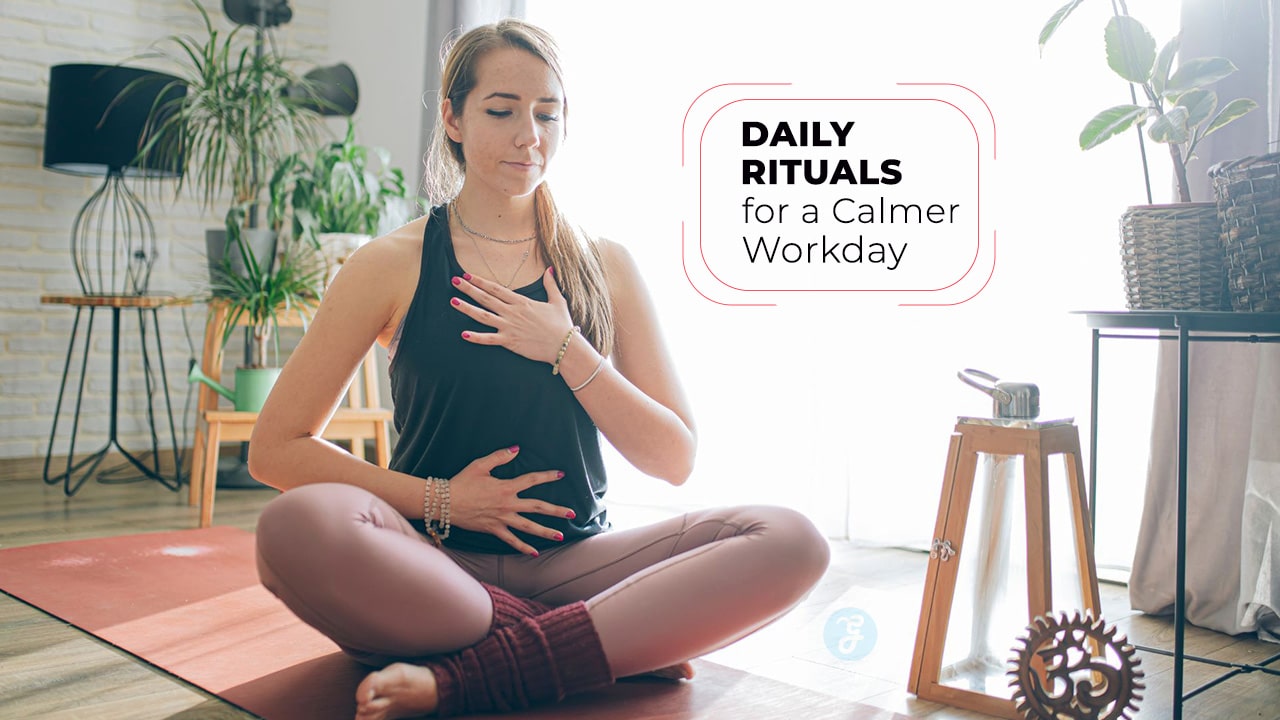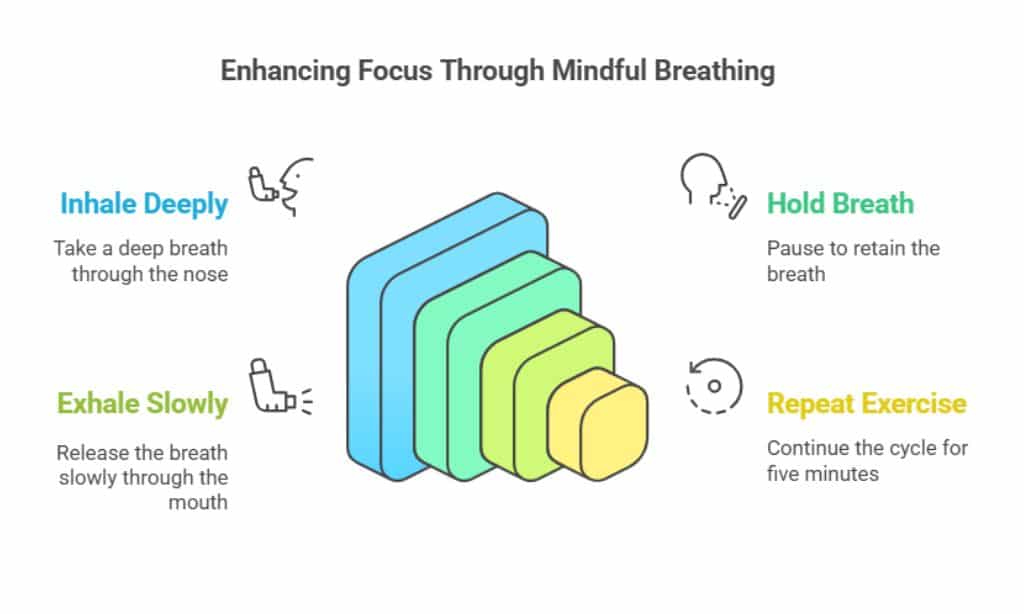In today’s fast-paced world, workplace stress has become a common challenge. Many professionals struggle to maintain focus, manage overwhelming workloads, and find balance amid constant demands.
The key to overcoming this chaos lies in implementing daily rituals for a calmer workday—simple yet powerful habits that can significantly improve mental clarity, reduce stress, and enhance productivity.
By incorporating structured habits into your daily routine, you can create a work environment that promotes mindfulness, efficiency, and well-being. These rituals are backed by research and widely used by successful professionals to optimize their work performance while maintaining a stress-free mindset.
In this article, we explore 10 daily rituals for a calmer workday that can help you achieve a more peaceful and productive professional life.
Why Daily Rituals Matter for a Calmer Workday
Before diving into the specific daily rituals for a calmer workday, it’s essential to understand their significance. Our brains thrive on consistency, and structured routines help regulate emotions, minimize decision fatigue, and improve focus. Research suggests that employees who follow a set of daily rituals experience lower stress levels and higher job satisfaction.
Benefits of Daily Rituals for a Calmer Workday:
| Benefit | Explanation |
| Reduces Anxiety | Daily habits help create predictability and security, lowering stress. |
| Improves Focus | Structured routines reduce distractions and enhance productivity. |
| Boosts Energy | Certain rituals, like hydration and movement, contribute to sustained energy levels. |
| Enhances Well-being | Mindfulness and gratitude practices improve emotional resilience. |
Now, let’s explore 10 daily rituals for a calmer workday that can transform how you approach your work life.
10 Daily Rituals for a Calmer Workday
Finding balance in a busy work environment can be challenging, but small daily habits can make a significant impact. Establishing consistent rituals can help professionals reduce stress, enhance productivity, and maintain a sense of calm throughout the day.
These simple yet powerful practices can be seamlessly incorporated into your routine to foster better mental well-being and efficiency.
1. Start Your Day with Mindful Breathing
How you start your morning sets the tone for the rest of the day. One of the simplest yet most effective daily rituals for a calmer workday is mindful breathing. Taking deep, intentional breaths helps activate the parasympathetic nervous system, reducing stress and improving focus. Studies show that mindful breathing can lower cortisol levels and enhance mental clarity.
Quick 5-Minute Breathing Exercise:
| Step | Action |
| 1 | Find a quiet space and sit comfortably. |
| 2 | Inhale deeply through your nose for four seconds. |
| 3 | Hold the breath for four seconds. |
| 4 | Exhale slowly through your mouth for six seconds. |
| 5 | Repeat for five minutes. |
Practicing mindful breathing before starting work can enhance mental clarity and create a sense of calm.
2. Set Clear Intentions for the Day
Another essential daily ritual for a calmer workday is setting clear intentions. Instead of diving straight into emails or tasks, take a few moments to establish a purpose for the day. Setting intentions can improve motivation, prioritize tasks, and reduce decision fatigue.
Morning Intention-Setting Routine:
| Step | Action |
| 1 | Identify your top three priorities for the day. |
| 2 | Visualize achieving your goals with confidence. |
| 3 | Write down affirmations like: “I am focused and productive today.” |
| 4 | Review your intentions mid-day to stay on track. |
Setting clear intentions helps align your mindset with your objectives, reducing stress and increasing productivity.
3. Optimize Your Workspace for Serenity
A cluttered workspace can contribute to mental chaos. Organizing your physical and digital space is one of the most effective daily rituals for a calmer workday to improve focus and reduce anxiety.
Workspace Optimization Tips:
| Element | Optimization Tip |
| Desk | Keep only essential items, remove clutter. |
| Lighting | Use natural light or warm-toned lamps. |
| Plants | Add greenery for a calming effect. |
| Noise | Use white noise or instrumental music. |
A well-organized workspace fosters a sense of order and enhances efficiency.
4. Take Short, Intentional Breaks
Working non-stop can lead to burnout. One of the best daily rituals for a calmer workday is incorporating short, intentional breaks. Regular breaks prevent cognitive overload and help sustain focus throughout the day.
Best Break Strategies:
| Strategy | Description |
| Pomodoro Technique | Work for 25 minutes, then take a 5-minute break. |
| Movement Breaks | Stretch, walk, or do light exercises. |
| Mindful Moments | Step away from the screen and focus on deep breathing. |
Short breaks help reset your mind and maintain consistent productivity.
5. Stay Hydrated and Eat Mindfully
Proper hydration and nutrition play a crucial role in maintaining energy levels and mental clarity. A well-nourished body leads to better cognitive function, improved mood, and sustained productivity throughout the day.
Healthy Workday Nutrition Tips
| Habit | Benefit |
| Drink water frequently | Prevents fatigue and improves concentration. |
| Eat balanced meals | Keeps blood sugar levels stable, preventing energy crashes. |
| Avoid excessive caffeine | Reduces anxiety, jitteriness, and afternoon energy slumps. |
| Incorporate healthy snacks | Provides sustained energy and prevents overeating at meals. |
| Practice mindful eating | Enhances digestion and satisfaction with meals. |
Practical Hydration and Eating Tips:
- Start your day with a glass of water to replenish fluids lost overnight.
- Keep a water bottle at your desk and set reminders to take sips throughout the day.
- Opt for nutrient-dense snacks like nuts, yogurt, or fruit to maintain energy.
- Eat away from your workspace to encourage mindful eating and reduce distractions.
- Limit processed foods and sugary drinks to avoid energy spikes and crashes.
Staying hydrated and eating mindfully helps sustain focus, productivity, and overall well-being.
6. Use Music or Background Sounds for Focus
Music and background sounds can improve concentration and reduce workplace stress. The right sounds can help mask distractions, enhance cognitive function, and create an environment conducive to deep work.
Recommended Soundscapes
| Type | Benefit |
| Classical music | Enhances cognitive performance and memory retention. |
| White noise | Blocks out distracting sounds, improving focus. |
| Nature sounds | Promotes relaxation, reduces stress, and enhances creativity. |
| Instrumental music | Helps maintain concentration without distracting lyrics. |
| Binaural beats | Can induce a state of deep focus and mental clarity. |
Tips for Using Sound Effectively:
- Experiment with different types of sounds to find what works best for your focus levels.
- Use noise-canceling headphones to block external distractions in noisy environments.
- Adjust volume levels so the sound enhances focus rather than becoming a distraction.
- Create playlists with sounds that help you enter a state of flow during deep work sessions.
Finding the right auditory environment can help boost efficiency and make work more enjoyable.
7. Practice Gratitude Throughout the Day
Expressing gratitude can improve mood, reduce stress, and enhance workplace satisfaction. Acknowledging the positives in your daily routine can lead to a more fulfilling and productive work experience.
Ways to Incorporate Gratitude
| Activity | Benefit |
| Keep a gratitude journal | Helps shift focus to positive aspects of life and work. |
| Express appreciation | Strengthens relationships with colleagues and boosts morale. |
| Start meetings with gratitude | Sets a positive tone and encourages team connection. |
| Reflect on daily wins | Increases motivation and reinforces a sense of accomplishment. |
| Send thank-you messages | Enhances workplace culture and builds goodwill. |
Practical Gratitude Practices:
- Begin your day by listing three things you’re grateful for.
- Acknowledge coworkers’ contributions with a simple “thank you” or a shout-out.
- Pause for a gratitude break when feeling overwhelmed to regain perspective.
- End your workday with a gratitude reflection to reinforce a positive mindset.
Integrating gratitude into your daily routine can lead to a more enjoyable and rewarding work life.
8. Minimize Digital Distractions
Excessive digital interruptions can hinder productivity, increase stress, and disrupt workflow. Managing screen time and setting boundaries can help maintain focus and efficiency.
Tips to Reduce Digital Distractions
| Strategy | Benefit |
| Turn off notifications | Reduces constant interruptions, enhancing deep focus. |
| Use time-blocking | Allocates specific periods for tasks, improving efficiency. |
| Limit social media usage | Prevents distractions and procrastination. |
| Set up a dedicated workspace | Creates an environment conducive to focus and productivity. |
| Use website blockers | Prevents access to distracting sites during work hours. |
Practical Ways to Stay Focused:
- Schedule “no-screen” time for deep work sessions.
- Use productivity apps like Pomodoro timers to stay on track.
- Keep your phone on silent or in another room during focused tasks.
- Organize your digital workspace by decluttering your desktop and email inbox.
Minimizing digital distractions allows for more meaningful and efficient work sessions, leading to higher productivity and less stress.
9. Take Regular Breaks to Recharge
Short breaks throughout the workday can help maintain productivity, reduce burnout, and improve overall well-being.
Effective Break Strategies
| Break Type | Benefit |
| 5-minute microbreaks | Prevents eye strain and physical fatigue. |
| Short walks | Boosts circulation and refreshes the mind. |
| Stretching exercises | Reduces muscle tension and improves posture. |
| Breathing exercises | Lowers stress levels and promotes relaxation. |
| Power naps (10-20 min) | Enhances alertness and cognitive performance. |
Tips for Taking Breaks Effectively:
- Step away from your screen every hour to rest your eyes.
- Use the Pomodoro Technique (25-minute work sessions, 5-minute breaks).
- Engage in light movement like stretching or walking to re-energize.
- Try mindfulness or deep breathing exercises for relaxation.
- Avoid using breaks for excessive social media scrolling to prevent mental fatigue.
Regular breaks can improve focus and sustain energy levels throughout the workday.
10. Maintain an Organized Workspace
An organized workspace can boost efficiency, reduce stress, and enhance creativity.
Workspace Organization Tips
| Strategy | Benefit |
| Declutter regularly | Reduces distractions and enhances focus. |
| Use storage solutions | Keeps essential items easily accessible. |
| Label files and folders | Improves efficiency and reduces time wasted searching. |
| Optimize lighting | Prevents eye strain and creates a comfortable environment. |
| Personalize your space | Enhances motivation and workplace satisfaction. |
Steps to Keep Your Workspace Tidy:
- Sort and file documents to prevent clutter.
- Keep only necessary items on your desk.
- Use organizers or drawers to store office supplies.
- Wipe down your workspace daily for a clean and refreshing environment.
A well-maintained workspace promotes productivity and a sense of control over your work environment.
Takeaways
Implementing daily rituals for a calmer workday can transform your professional life. By adopting small but meaningful habits, you can create a more peaceful, productive, and fulfilling work environment. Start with one or two rituals and gradually build a routine that works best for you!










































